Make a quantile-quantile plot of a sample
create.qqplot.fit.RdTakes a sample and creates a qq plot against a theoretical distribution, possibly conditioned on other variables.
Usage
create.qqplot.fit(
x,
data = NA,
filename = NULL,
groups = NULL,
confidence.bands = FALSE,
conf = 0.95,
confidence.method = 'both',
reference.line.method = 'quartiles',
distribution = qnorm,
aspect = 'fill',
prepanel = NULL,
main = NULL,
main.just = 'center',
main.x = 0.5,
main.y = 0.5,
main.cex = 3,
xlab.label = NULL,
ylab.label = NULL,
xlab.cex = 2,
ylab.cex = 2,
xlab.col = 'black',
ylab.col = 'black',
xlab.top.label = NULL,
xlab.top.cex = 2,
xlab.top.col = 'black',
xlab.top.just = 'center',
xlab.top.x = 0.5,
xlab.top.y = 0,
xlimits = NULL,
ylimits = NULL,
xat = TRUE,
yat = TRUE,
xaxis.lab = NA,
yaxis.lab = NA,
xaxis.cex = 1.5,
yaxis.cex = 1.5,
xaxis.col = 'black',
yaxis.col = 'black',
xaxis.fontface = 'bold',
yaxis.fontface = 'bold',
xaxis.log = FALSE,
yaxis.log = FALSE,
xaxis.rot = 0,
yaxis.rot = 0,
xaxis.tck = 1,
yaxis.tck = 1,
add.grid = FALSE,
xgrid.at = xat,
ygrid.at = yat,
type = 'p',
cex = 0.75,
pch = 19,
col = 'black',
col.line = 'grey',
lwd = 2,
lty = 1,
axes.lwd = 2.25,
key = list(text = list(lab = c(''))),
legend = NULL,
add.rectangle = FALSE,
xleft.rectangle = NULL,
ybottom.rectangle = NULL,
xright.rectangle = NULL,
ytop.rectangle = NULL,
col.rectangle = 'transparent',
alpha.rectangle = 1,
top.padding = 3,
bottom.padding = 0.7,
left.padding = 0.5,
right.padding = 0.1,
height = 6,
width = 6,
size.units = 'in',
resolution = 1600,
enable.warnings = FALSE,
description = 'Created with BoutrosLab.plotting.general',
style = 'BoutrosLab',
preload.default = 'custom',
use.legacy.settings = FALSE,
inside.legend.auto = FALSE
);Arguments
- x
A formula or a numeric vector
- data
An optional data source if x is a formula
- filename
Filename for tiff output, or if NULL returns the trellis object itself
- groups
The grouping variable in the data-frame
- confidence.bands
Add confidence bands or not, default to FALSE. Note that in this function, the confidence band can only be added to a single plot, not for multi-qq plot.
- conf
Confidence level, default to 0.95
- confidence.method
Methods used to draw confidence bands: “simultaneous”, “pointwise”, “both”, defaults to “both”.
- reference.line.method
Methods used to draw reference line and must be one of “quartiles”(default), “diagonal”, “robust”. “quartiles” will draw a line across 1/4 and 3/4 quantiles, “diagonal” will draw a 0-1 line, “robust” will draw a best fit line basing on linear model. Note: for multi-panel plot, only the default one is applicable.
- distribution
A quantile function that takes a vector of probabilities as argument and produces the corresponding quantiles from a theoretical distribution, defaults to “qnorm”, that is normal distribution.
- aspect
This argument controls the physical aspect ratio of the panels, defaults to “fill”
- prepanel
A function that takes the same arguments as the “panel”
- main
The main plot title
- main.just
The justification of the main title for the plot, default is centered
- main.x
The x location of the main title, deault is 0.5
- main.y
The y location of the main title, default is 0.5
- main.cex
Size of the overall plot title, defaults to 3
- xlab.label
x-axis title
- ylab.label
y-axis title
- xlab.cex
Size of x-axis label, defaults to 2.5
- ylab.cex
Size of y-axis label, defaults to 2.5
- xlab.col
Colour of the x-axis label, defaults to “black”
- ylab.col
Colour of the y-axis label, defaults to “black”
- xlab.top.label
The label for the top x-axis
- xlab.top.cex
Size of top x-axis label
- xlab.top.col
Colour of the top x-axis label
- xlab.top.just
Justification of the top x-axis label, defaults to centered
- xlab.top.x
The x location of the top x-axis label
- xlab.top.y
The y location of the top y-axis label
- xlimits
Two-element vector giving the x-axis limits, defaults to automatic
- ylimits
Two-element vector giving the y-axis limits, defaults to automatic
- xat
Vector listing where the x-axis labels should be drawn, defaults to automatic
- yat
Vector listing where the y-axis labels should be drawn, defaults to automatic
- xaxis.lab
Vector listing x-axis tick labels, defaults to automatic
- yaxis.lab
Vector listing y-axis tick labels, defaults to automatic
- xaxis.cex
Size of x-axis scales, defaults to 1.5
- yaxis.cex
Size of y-axis scales, defaults to 1.5
- xaxis.col
Colour of the x-axis tick labels, defaults to “black”
- yaxis.col
Colour of the y-axis tick labels, defaults to “black”
- xaxis.fontface
Fontface for the x-axis scales
- yaxis.fontface
Fontface for the y-axis scales
- xaxis.log
Logical indicating whether x-variable should be in logarithmic scale (and what base if numeric)
- yaxis.log
Logical indicating whether y-variable should be in logarithmic scale (and what base if numeric)
- xaxis.rot
Counterclockwise rotation of text in x-axis scales in degrees, defaults to 0
- yaxis.rot
Counterclockwise rotation of text in y-axis scales in degrees, defaults to 0
- xaxis.tck
Specifies the length of the tick marks for x-axis, defaults to 1
- yaxis.tck
Specifies the length of the tick marks for y-axis, defaults to 1
- add.grid
Default manner of drawing grid lines
- xgrid.at
Vector listing where the x-axis grid lines should be drawn, defaults to xat
- ygrid.at
Vector listing where the y-axis grid lines should be drawn, defaults to yat
- type
Plot type
- cex
Character expansion for plotting symbol
- pch
Plotting character
- col
Point colour
- col.line
QQ line colour, defaults to grey
- lwd
Specifies line width, defaults to 2
- lty
Specifies line style, defaults to 1 (solid)
- axes.lwd
Thickness of width of axes lines
- key
A list giving the key (legend). The default suppresses drawing
- legend
Add a legend to the plot. Helpful for adding multiple keys and adding keys to the margins of the plot. See xyplot.
- add.rectangle
Allow a rectangle to be drawn, default is FALSE
- xleft.rectangle
Specifies the left x ooordinate of the rectangle to be drawn
- ybottom.rectangle
Specifies the bottom y coordinate of the rectangle to be drawn
- xright.rectangle
Specifies the right x coordinate of the rectangle to be drawn
- ytop.rectangle
Specifies the top y coordinate of the rectangle to be drawn
- col.rectangle
Specifies the colour to fill the rectangle's area
- alpha.rectangle
Specifies the colour bias of the rectangle to be drawn
- top.padding
A number giving the top padding in multiples of the lattice default
- bottom.padding
A number giving the bottom padding in multiples of the lattice default
- left.padding
A number giving the left padding in multiples of the lattice default
- right.padding
A number giving the right padding in multiples of the lattice default
- height
Figure height, defaults to 6 inches
- width
Figure width, defaults to 6 inches
- size.units
Figure units, defaults to inches
- resolution
Figure resolution in dpi, defaults to 1600
- enable.warnings
Print warnings if set to TRUE, defaults to FALSE
- description
Short description of image/plot; default NULL.
- style
defaults to “BoutrosLab”, also accepts “Nature”, which changes parameters according to Nature formatting requirements
- preload.default
ability to set multiple sets of diffrent defaults depending on publication needs
- use.legacy.settings
boolean to set wheter or not to use legacy mode settings (font)
- inside.legend.auto
boolean specifying whether or not to use the automatic inside legend function
Value
If filename is NULL then returns the trellis object, otherwise creates a plot and returns a 0/1 success code.
Warning
Note that the confidence band only works for a single panel qq plot, not for grouped data and multi-qq plot. Why? What's missing?
Examples
set.seed(12345);
create.qqplot.fit(
# filename = tempfile(pattern = 'QQfit_Simple', fileext = '.tiff'),
x = rnorm(300),
# choosing to compare against a uniform distribution
distribution = qunif,
resolution = 100
);
#> Warning: explicit 'data' specification ignored
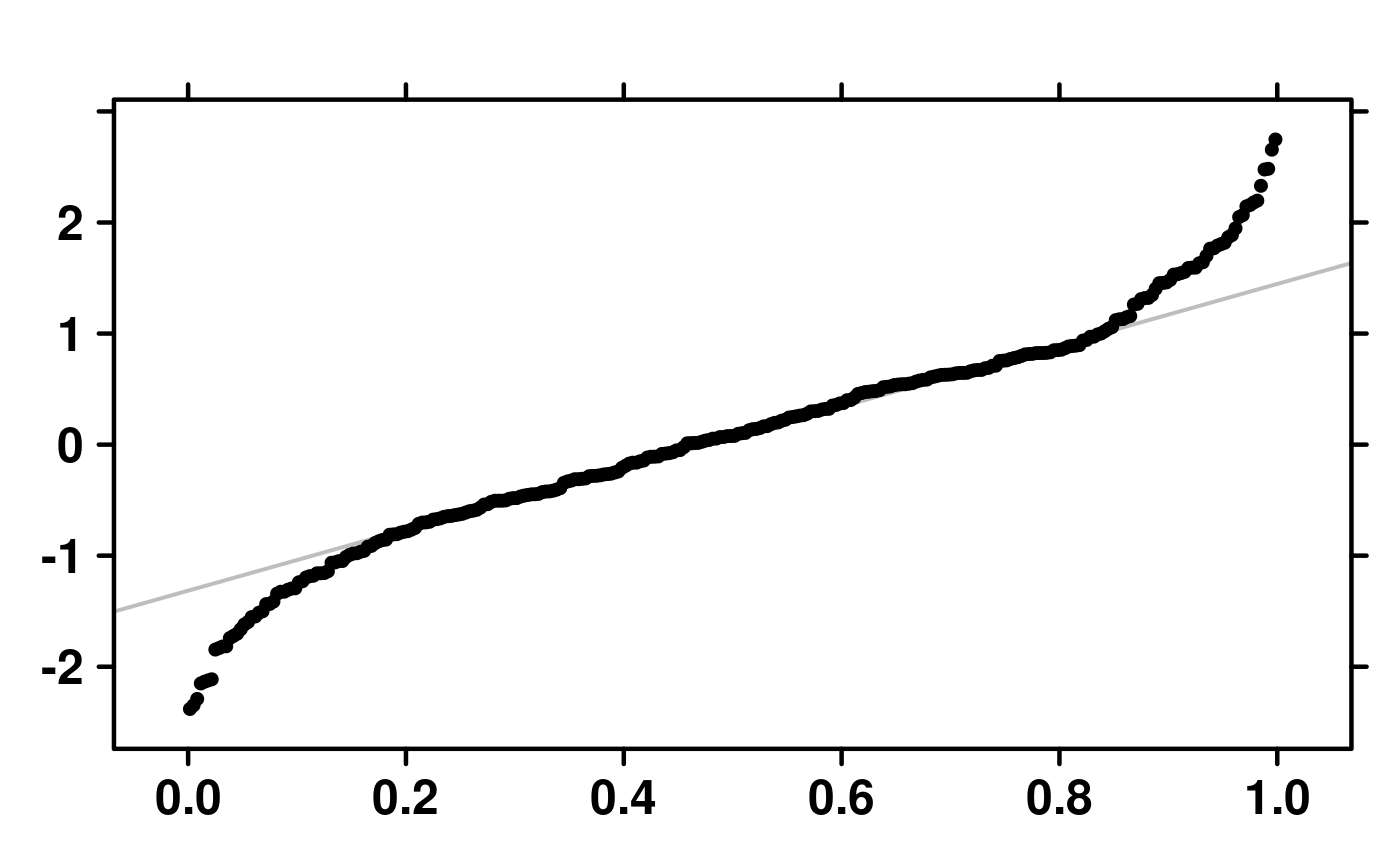 # Minimal Input
create.qqplot.fit(
# filename = tempfile(pattern = 'QQfit_Minimal_Input', fileext = '.tiff'),
x = microarray[1:500,1],
# choosing to compare against a uniform distribution
distribution = qunif,
main = 'Minimal input',
description = 'QQplot fit created by BoutrosLab.plotting.general',
resolution = 100
);
#> Warning: explicit 'data' specification ignored
# Minimal Input
create.qqplot.fit(
# filename = tempfile(pattern = 'QQfit_Minimal_Input', fileext = '.tiff'),
x = microarray[1:500,1],
# choosing to compare against a uniform distribution
distribution = qunif,
main = 'Minimal input',
description = 'QQplot fit created by BoutrosLab.plotting.general',
resolution = 100
);
#> Warning: explicit 'data' specification ignored
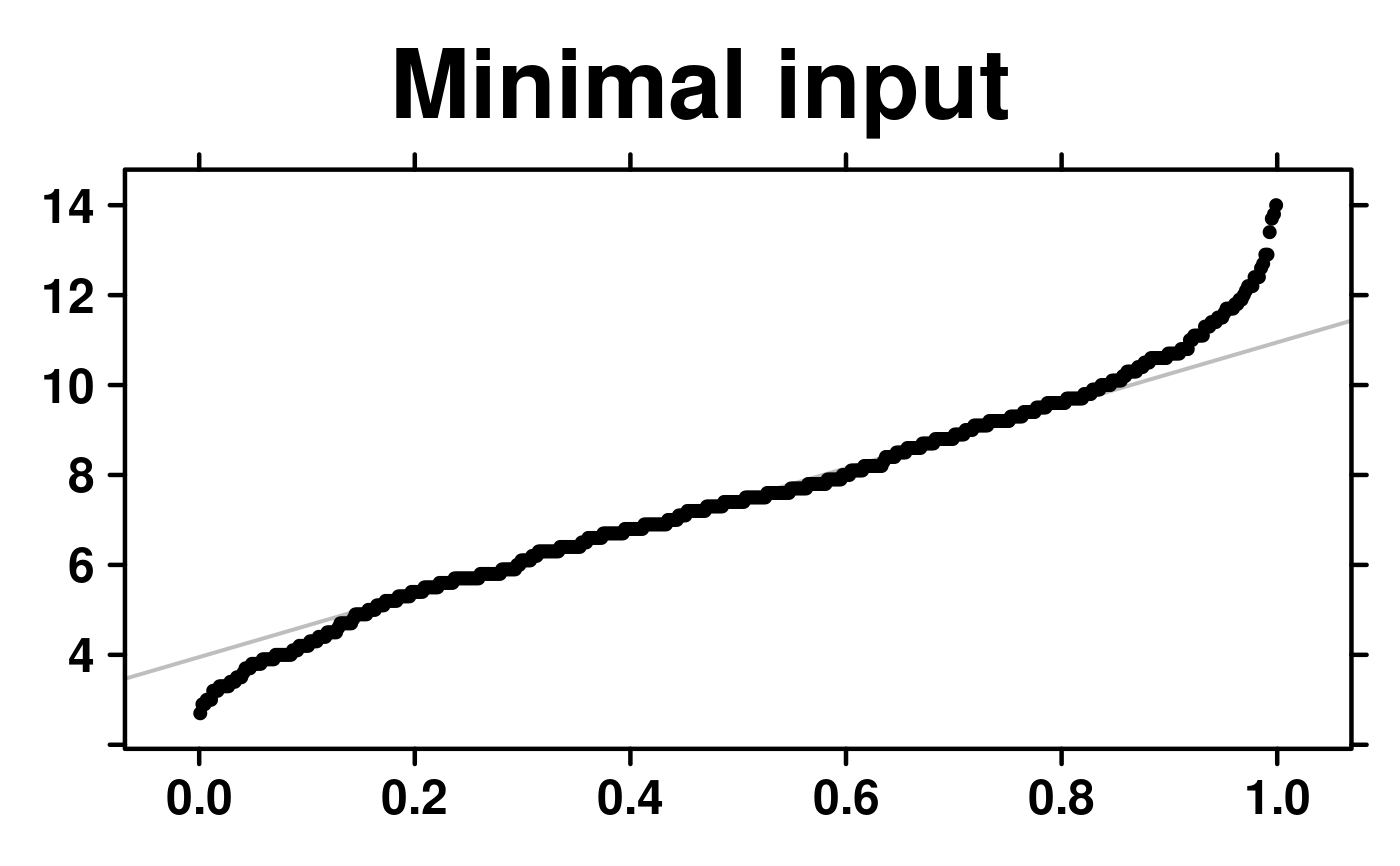 # Axes and Labels
create.qqplot.fit(
# filename = tempfile(pattern = 'QQfit_Axes_Labels', fileext = '.tiff'),
x = microarray[1:500,1],
distribution = qunif,
main = 'Axes & labels',
# Adding axes labels
xlab.label = 'qunif',
ylab.label = 'sample values',
xlab.cex = 1.5,
ylab.cex = 1.5,
xaxis.fontface = 1,
yaxis.fontface = 1,
xaxis.cex = 1,
yaxis.cex = 1,
add.grid = TRUE,
description = 'QQplot fit created by BoutrosLab.plotting.general',
resolution = 100
);
#> Warning: explicit 'data' specification ignored
# Axes and Labels
create.qqplot.fit(
# filename = tempfile(pattern = 'QQfit_Axes_Labels', fileext = '.tiff'),
x = microarray[1:500,1],
distribution = qunif,
main = 'Axes & labels',
# Adding axes labels
xlab.label = 'qunif',
ylab.label = 'sample values',
xlab.cex = 1.5,
ylab.cex = 1.5,
xaxis.fontface = 1,
yaxis.fontface = 1,
xaxis.cex = 1,
yaxis.cex = 1,
add.grid = TRUE,
description = 'QQplot fit created by BoutrosLab.plotting.general',
resolution = 100
);
#> Warning: explicit 'data' specification ignored
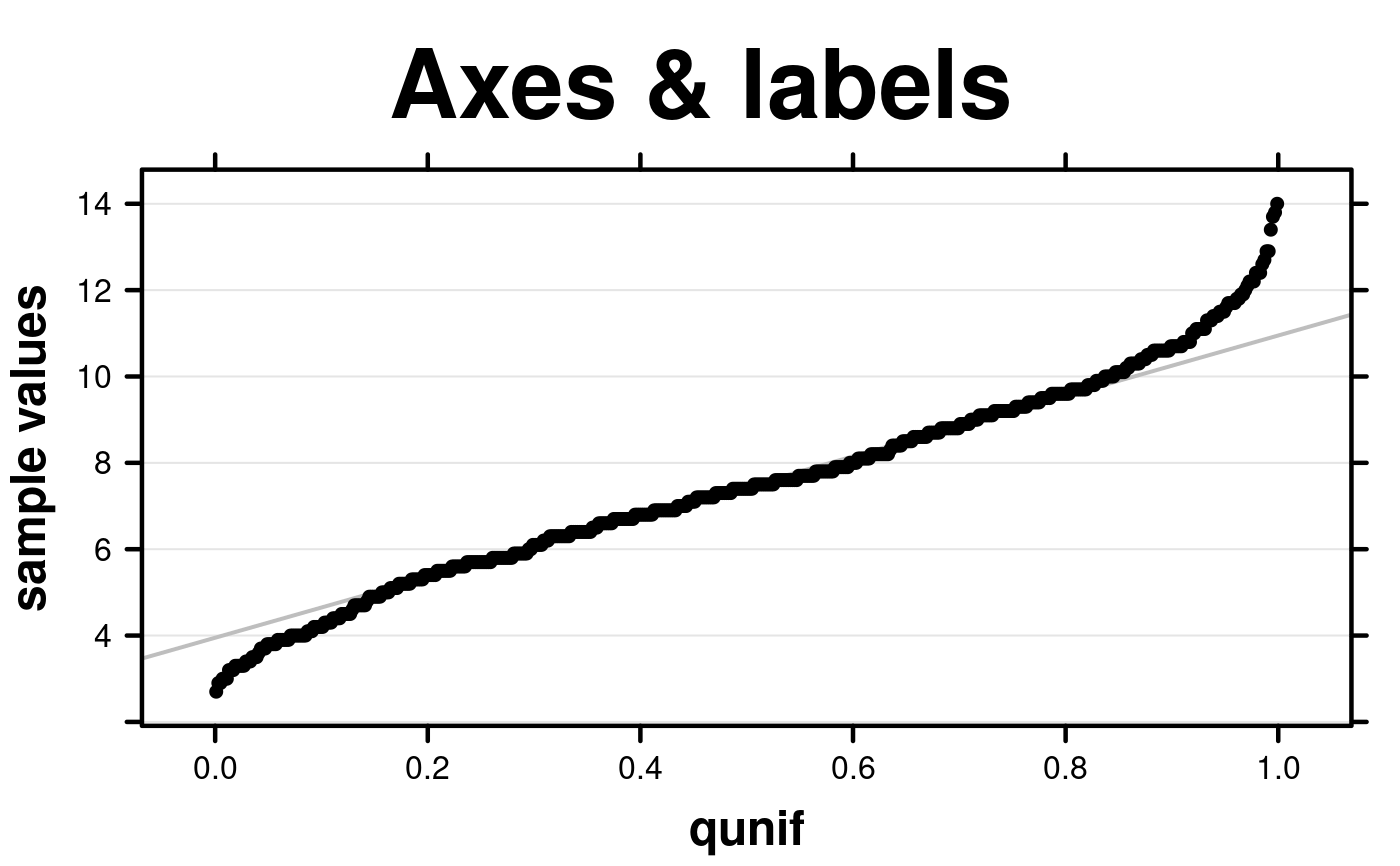 # Confidence bands
create.qqplot.fit(
# filename = tempfile(pattern = 'QQfit_Confidence_Bands', fileext = '.tiff'),
x = microarray[1:500,1],
distribution = qunif,
main = 'Confidence bands',
xlab.label = 'qunif',
ylab.label = 'sample values',
xlab.cex = 1.5,
ylab.cex = 1.5,
xaxis.fontface = 1,
yaxis.fontface = 1,
xaxis.cex = 1,
yaxis.cex = 1,
add.grid = TRUE,
# Adding confidence bands (auto-generates legend)
confidence.bands = TRUE,
confidence.method = 'both',
description = 'QQplot fit created by BoutrosLab.plotting.general',
resolution = 100
);
#> Warning: explicit 'data' specification ignored
# Confidence bands
create.qqplot.fit(
# filename = tempfile(pattern = 'QQfit_Confidence_Bands', fileext = '.tiff'),
x = microarray[1:500,1],
distribution = qunif,
main = 'Confidence bands',
xlab.label = 'qunif',
ylab.label = 'sample values',
xlab.cex = 1.5,
ylab.cex = 1.5,
xaxis.fontface = 1,
yaxis.fontface = 1,
xaxis.cex = 1,
yaxis.cex = 1,
add.grid = TRUE,
# Adding confidence bands (auto-generates legend)
confidence.bands = TRUE,
confidence.method = 'both',
description = 'QQplot fit created by BoutrosLab.plotting.general',
resolution = 100
);
#> Warning: explicit 'data' specification ignored
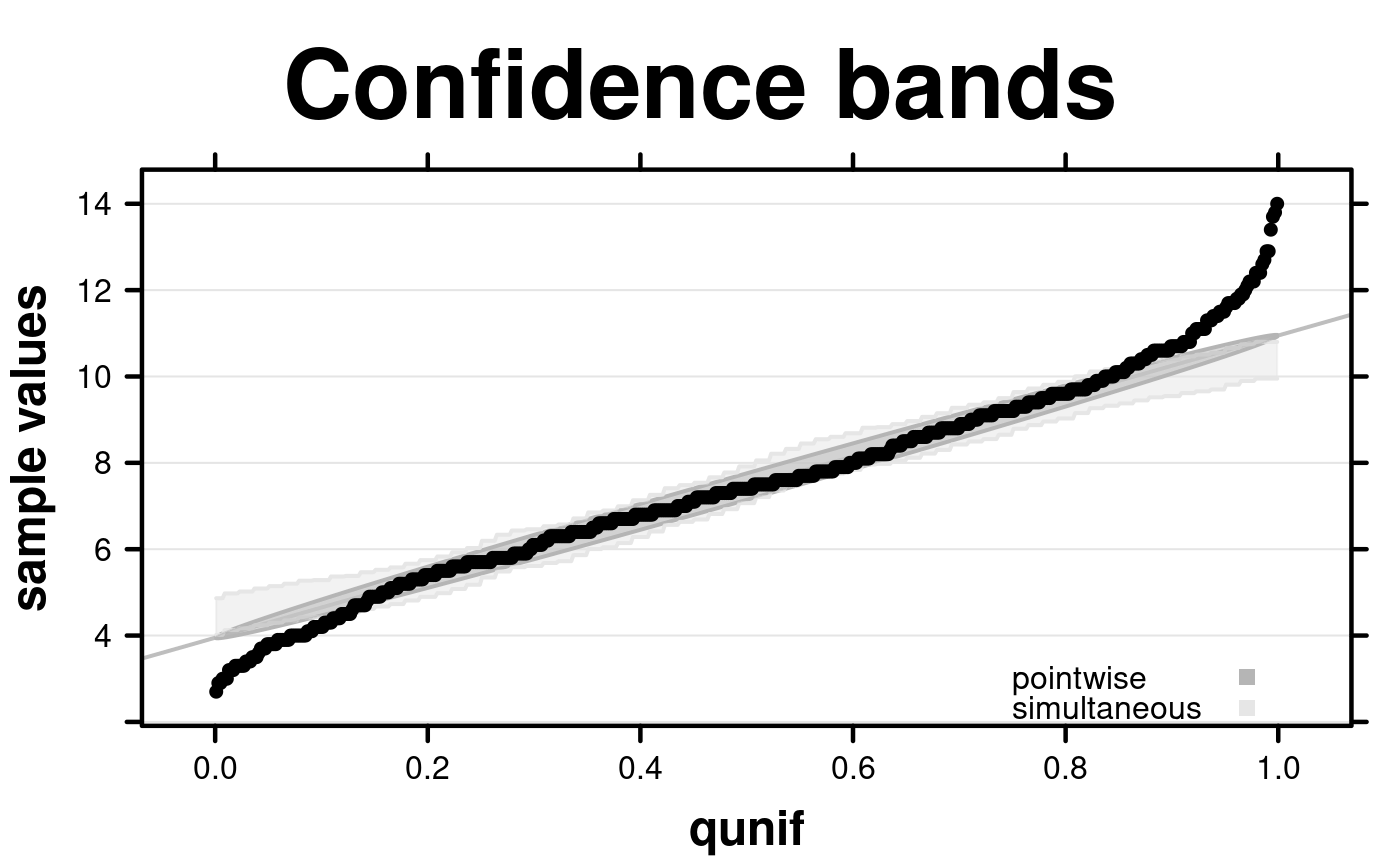 # \donttest{
# Multiple qq plot conditioned on a variable
# 'Formula' format of data
chr.locations <- microarray$Chr[1:500];
chr.locations <- replace(chr.locations, which(chr.locations == 1), 'Chromosome 1');
chr.locations <- replace(chr.locations, which(chr.locations == 2), 'Chromosome 2');
qqplot.data <- data.frame(
value = microarray[1:500,1],
chr = chr.locations
);
create.qqplot.fit(
# filename = tempfile(pattern = 'QQfit_Multiple', fileext = '.tiff'),
x = ~ value | chr,
data = qqplot.data,
distribution = qunif,
main = 'Multiple plots',
xlab.label = 'qunif',
ylab.label = 'sample values',
xlab.cex = 1.5,
ylab.cex = 1.5,
xaxis.fontface = 1,
yaxis.fontface = 1,
xaxis.cex = 1,
yaxis.cex = 1,
add.grid = TRUE,
confidence.bands = TRUE,
confidence.method = 'simultaneous',
description = 'QQplot fit created by BoutrosLab.plotting.general',
resolution = 100
);
# \donttest{
# Multiple qq plot conditioned on a variable
# 'Formula' format of data
chr.locations <- microarray$Chr[1:500];
chr.locations <- replace(chr.locations, which(chr.locations == 1), 'Chromosome 1');
chr.locations <- replace(chr.locations, which(chr.locations == 2), 'Chromosome 2');
qqplot.data <- data.frame(
value = microarray[1:500,1],
chr = chr.locations
);
create.qqplot.fit(
# filename = tempfile(pattern = 'QQfit_Multiple', fileext = '.tiff'),
x = ~ value | chr,
data = qqplot.data,
distribution = qunif,
main = 'Multiple plots',
xlab.label = 'qunif',
ylab.label = 'sample values',
xlab.cex = 1.5,
ylab.cex = 1.5,
xaxis.fontface = 1,
yaxis.fontface = 1,
xaxis.cex = 1,
yaxis.cex = 1,
add.grid = TRUE,
confidence.bands = TRUE,
confidence.method = 'simultaneous',
description = 'QQplot fit created by BoutrosLab.plotting.general',
resolution = 100
);
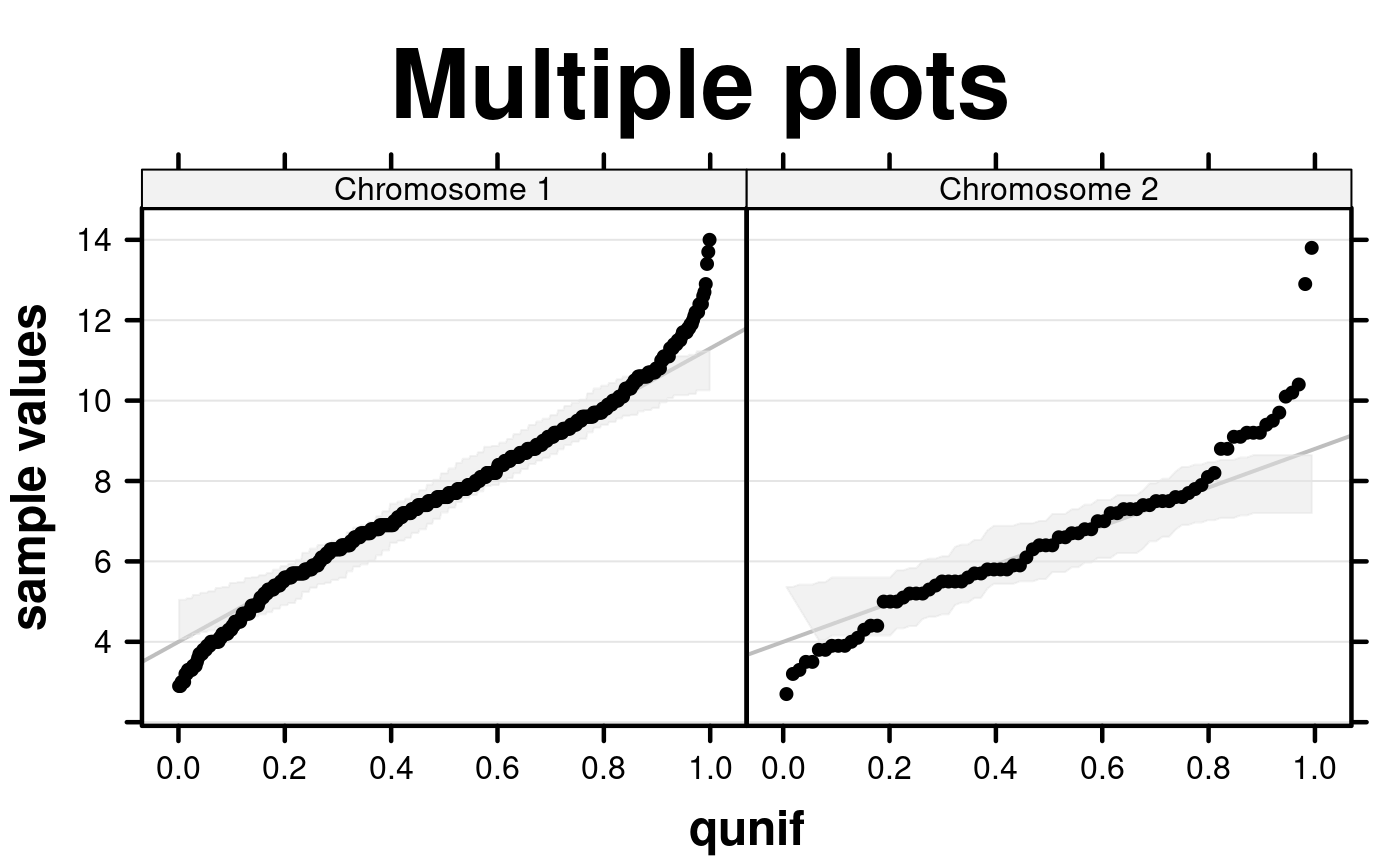 # Grouped qq plot
create.qqplot.fit(
# filename = tempfile(pattern = 'QQfit_Grouped', fileext = '.tiff'),
x = ~ value,
data = qqplot.data,
# Adding groups
groups = qqplot.data$chr,
# Colouring groups
col = default.colours(2),
# Setting different plotting characters
pch = c(15, 19),
distribution = qunif,
main = 'Grouped & legend',
xlab.label = 'qunif',
ylab.label = 'sample values',
xlab.cex = 1.5,
ylab.cex = 1.5,
xaxis.fontface = 1,
yaxis.fontface = 1,
xaxis.cex = 1,
yaxis.cex = 1,
add.grid = TRUE,
confidence.bands = TRUE,
confidence.method = 'simultaneous',
# Adding legend for groups
key = list(
text = list(
lab = c('1','2'),
cex = 1,
col = 'black'
),
points = list(
pch = c(15, 19),
col = default.colours(2),
cex = 1
),
x = 0.04,
y = 0.95,
padding.text = 2
),
description = 'QQplot fit created by BoutrosLab.plotting.general',
resolution = 100
);
# Grouped qq plot
create.qqplot.fit(
# filename = tempfile(pattern = 'QQfit_Grouped', fileext = '.tiff'),
x = ~ value,
data = qqplot.data,
# Adding groups
groups = qqplot.data$chr,
# Colouring groups
col = default.colours(2),
# Setting different plotting characters
pch = c(15, 19),
distribution = qunif,
main = 'Grouped & legend',
xlab.label = 'qunif',
ylab.label = 'sample values',
xlab.cex = 1.5,
ylab.cex = 1.5,
xaxis.fontface = 1,
yaxis.fontface = 1,
xaxis.cex = 1,
yaxis.cex = 1,
add.grid = TRUE,
confidence.bands = TRUE,
confidence.method = 'simultaneous',
# Adding legend for groups
key = list(
text = list(
lab = c('1','2'),
cex = 1,
col = 'black'
),
points = list(
pch = c(15, 19),
col = default.colours(2),
cex = 1
),
x = 0.04,
y = 0.95,
padding.text = 2
),
description = 'QQplot fit created by BoutrosLab.plotting.general',
resolution = 100
);
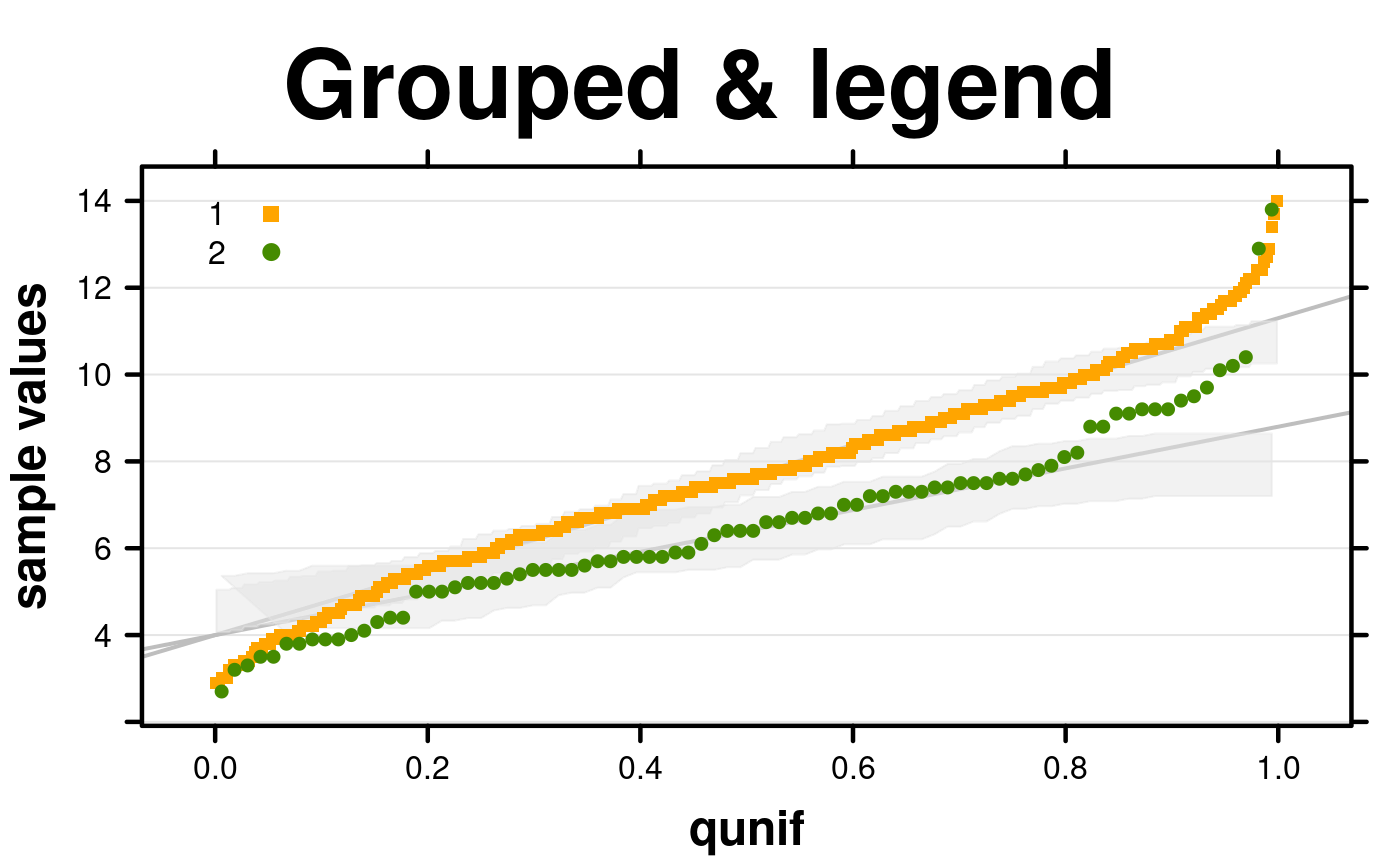 # Correlation Key
create.qqplot.fit(
# filename = tempfile(pattern = 'QQfit_Correlation_Key', fileext = '.tiff'),
x = ~ value,
data = qqplot.data,
groups = qqplot.data$chr,
col = default.colours(2),
pch = c(15, 19),
distribution = qunif,
main = 'Correlation key',
xlab.label = 'qunif',
ylab.label = 'sample values',
xlab.cex = 1.5,
ylab.cex = 1.5,
xaxis.fontface = 1,
yaxis.fontface = 1,
xaxis.cex = 1,
yaxis.cex = 1,
add.grid = TRUE,
confidence.bands = TRUE,
confidence.method = 'simultaneous',
# Adjusting legend to contain multiple keys
legend = list(
inside = list(
fun = draw.key,
args = list(
key = list(
text = list(
lab = c('1','2'),
cex = 1,
col = 'black'
),
points = list(
pch = c(15, 19),
col = default.colours(2),
cex = 1
),
x = 0.14,
y = 0.80,
padding.text = 2
)
)
),
inside = list(
fun = draw.key,
args = list(
key = get.corr.key(
x = runif(500),
y = qqplot.data$value,
label.items = c('spearman', 'kendall','beta1'),
alpha.background = 0,
key.cex = 1
)
),
x = 0.75,
y = 0.20,
corner = c(0,1)
)
),
description = 'QQplot fit created by BoutrosLab.plotting.general',
resolution = 100
);
#> Warning: Cannot compute exact p-value with ties
# Correlation Key
create.qqplot.fit(
# filename = tempfile(pattern = 'QQfit_Correlation_Key', fileext = '.tiff'),
x = ~ value,
data = qqplot.data,
groups = qqplot.data$chr,
col = default.colours(2),
pch = c(15, 19),
distribution = qunif,
main = 'Correlation key',
xlab.label = 'qunif',
ylab.label = 'sample values',
xlab.cex = 1.5,
ylab.cex = 1.5,
xaxis.fontface = 1,
yaxis.fontface = 1,
xaxis.cex = 1,
yaxis.cex = 1,
add.grid = TRUE,
confidence.bands = TRUE,
confidence.method = 'simultaneous',
# Adjusting legend to contain multiple keys
legend = list(
inside = list(
fun = draw.key,
args = list(
key = list(
text = list(
lab = c('1','2'),
cex = 1,
col = 'black'
),
points = list(
pch = c(15, 19),
col = default.colours(2),
cex = 1
),
x = 0.14,
y = 0.80,
padding.text = 2
)
)
),
inside = list(
fun = draw.key,
args = list(
key = get.corr.key(
x = runif(500),
y = qqplot.data$value,
label.items = c('spearman', 'kendall','beta1'),
alpha.background = 0,
key.cex = 1
)
),
x = 0.75,
y = 0.20,
corner = c(0,1)
)
),
description = 'QQplot fit created by BoutrosLab.plotting.general',
resolution = 100
);
#> Warning: Cannot compute exact p-value with ties
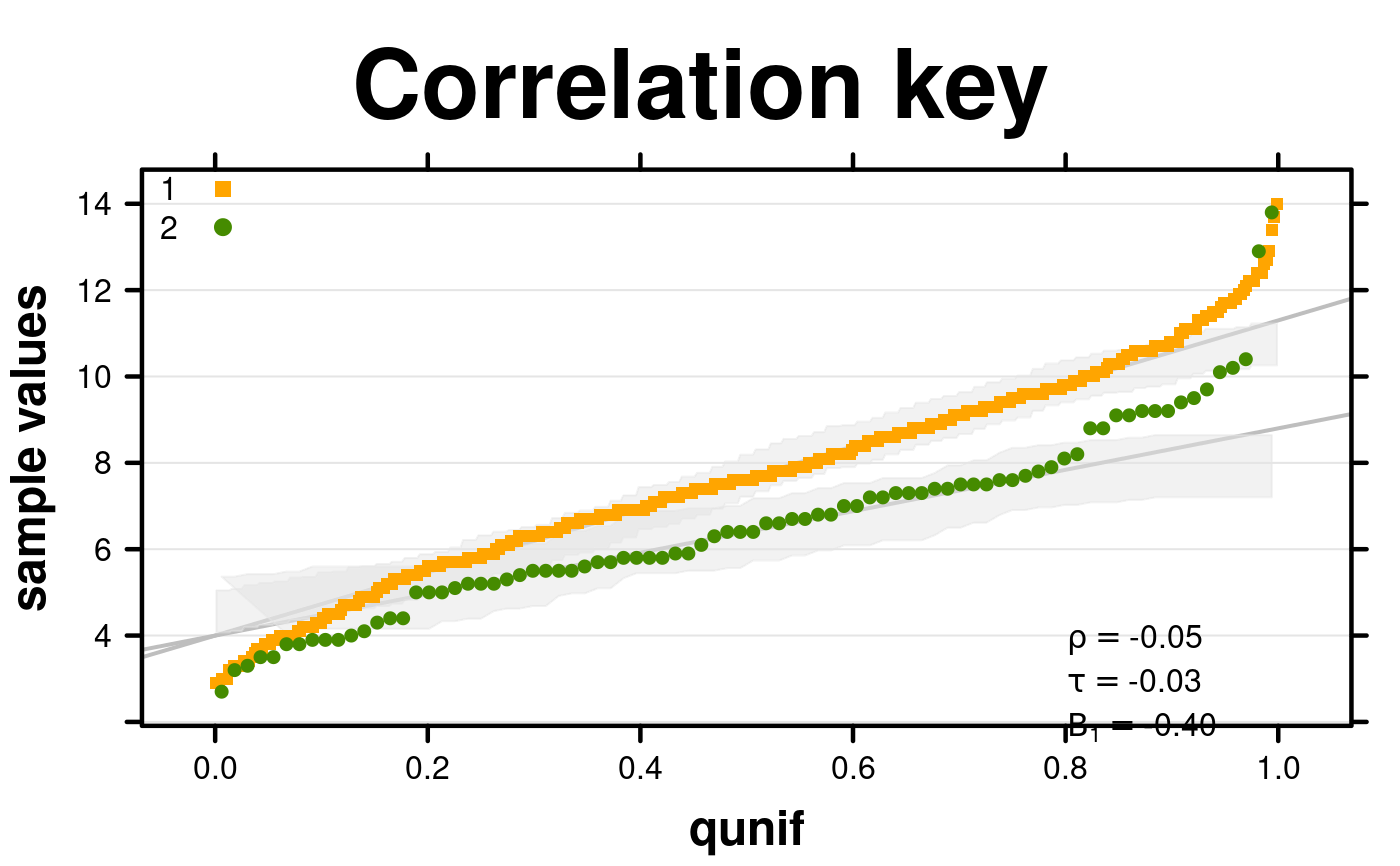 # Nature style
create.qqplot.fit(
# filename = tempfile(pattern = 'QQfit_Nature_style', fileext = '.tiff'),
x = microarray[1:500,1],
distribution = qunif,
main = 'Nature style',
xlab.cex = 1.5,
ylab.cex = 1.5,
xaxis.fontface = 1,
yaxis.fontface = 1,
xaxis.cex = 1,
yaxis.cex = 1,
add.grid = TRUE,
confidence.bands = TRUE,
confidence.method = 'both',
# set style to Nature
style = 'Nature',
# demonstrating how to italicize character variables
ylab.label = expression(paste('italicized ', italic('a'))),
# demonstrating how to create en-dashes
xlab.label = expression(paste('en dashs: 1','\u2013', '10'^'\u2013', ''^3)),
description = 'QQplot fit created by BoutrosLab.plotting.general',
resolution = 1200
);
#> Warning: explicit 'data' specification ignored
#> Warning: Nature also requires italicized single-letter variables and en-dashes
#> for ranges and negatives. See example in documentation for how to do this.
#> Warning: Avoid red-green colour schemes, create TIFF files, do not outline the figure or legend.
# Nature style
create.qqplot.fit(
# filename = tempfile(pattern = 'QQfit_Nature_style', fileext = '.tiff'),
x = microarray[1:500,1],
distribution = qunif,
main = 'Nature style',
xlab.cex = 1.5,
ylab.cex = 1.5,
xaxis.fontface = 1,
yaxis.fontface = 1,
xaxis.cex = 1,
yaxis.cex = 1,
add.grid = TRUE,
confidence.bands = TRUE,
confidence.method = 'both',
# set style to Nature
style = 'Nature',
# demonstrating how to italicize character variables
ylab.label = expression(paste('italicized ', italic('a'))),
# demonstrating how to create en-dashes
xlab.label = expression(paste('en dashs: 1','\u2013', '10'^'\u2013', ''^3)),
description = 'QQplot fit created by BoutrosLab.plotting.general',
resolution = 1200
);
#> Warning: explicit 'data' specification ignored
#> Warning: Nature also requires italicized single-letter variables and en-dashes
#> for ranges and negatives. See example in documentation for how to do this.
#> Warning: Avoid red-green colour schemes, create TIFF files, do not outline the figure or legend.
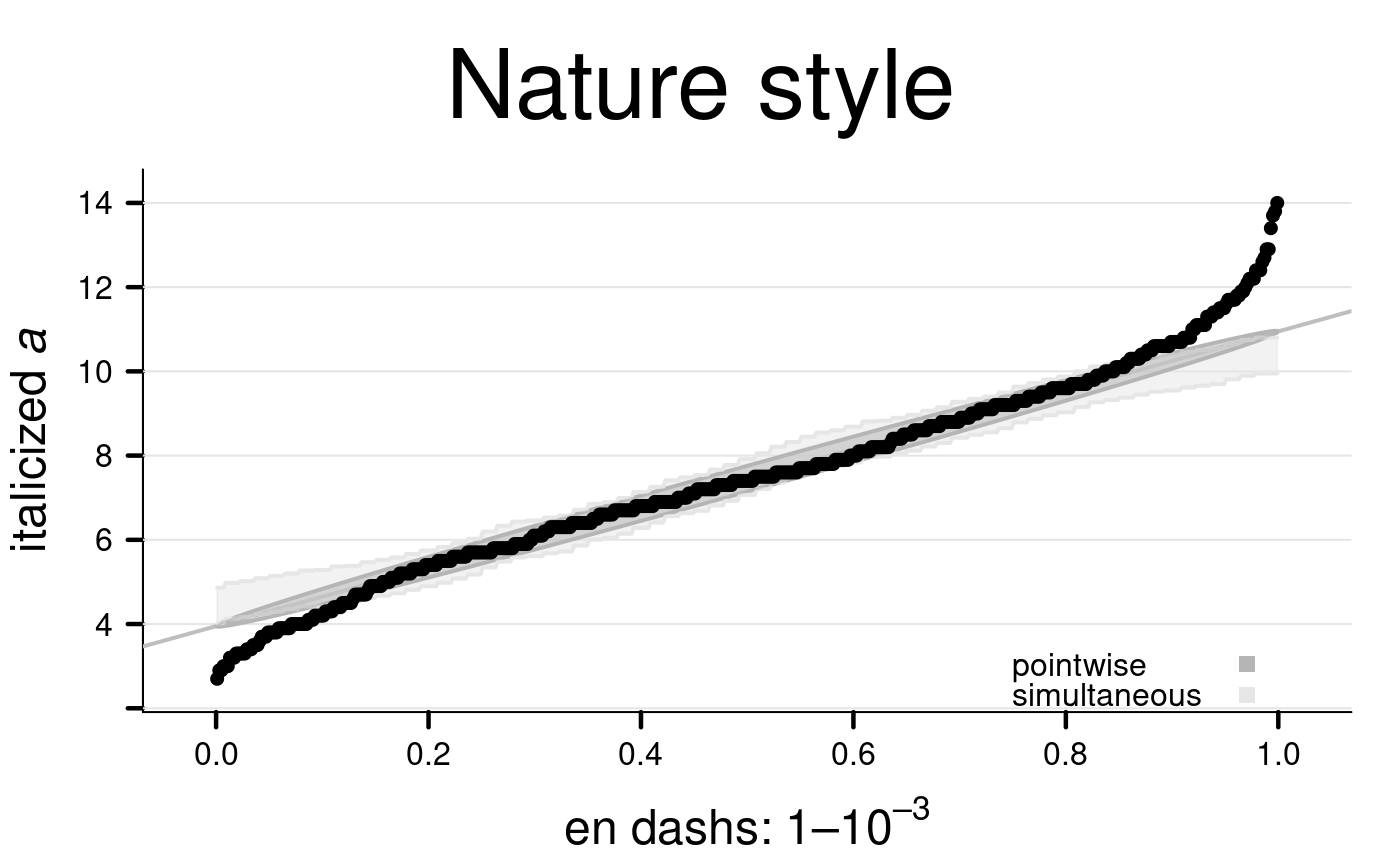 # }
# }